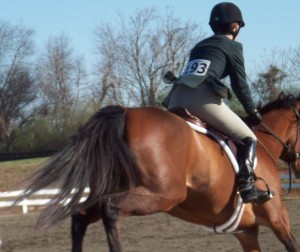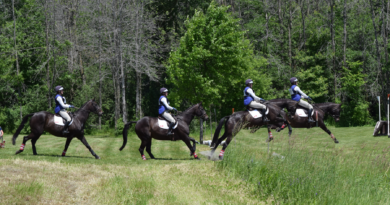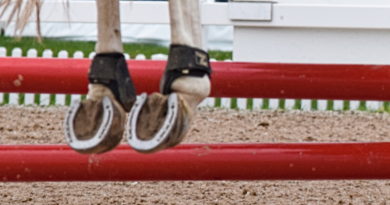Equitation – What the Judge is Looking For

When riding in the show ring your equitation will count. Even in classes that equitation is not being judged, how you ride and show a horse will help identify your horse as a show ring winner. Take for example a novice rider that noticably pulls on the reins to slow the horse down. What the judge may see is a horse that is opening its mouth and a rider that cannot slow the horse down. Contrast this to a skilled equitation rider that can use their body and well executed half halts to seamlessy slow the horse’s gait. Having the equitation skills will help show a horse.
A correctly ridden horse will be shown to its maximum potential. A good horse that is well ridden can often win over a superior horse that is poorly ridden. This is because a well rounded and experienced rider can develop and show the horse to its best advantage. A rider with less experience may not be able to apply the necessary aids to show the horse correctly.
To become a better rider you have to have a good base. Most of us have all the tools to become a good rider in our first year of riding. Sit with your seat in the deepest part of the saddle, legs are hanging down and relaxed at the horses sides. The joints of the hip knee and ankle are supple with the stirrup resting comfortably on the balls of the feet.
The upper body is straight with the arms hanging relaxed at your sides. Elbows are relaxed and bent at approximately 90degree angle. Important that the elbows are relaxed to absorb the movement of the horse and thereby keeping your hands still.
Independent seat
To improve your position your separate body parts have to move independently from each other. Your left arm has to be independent from your right arm and your left leg. When you have tension in part of your body it will influence your horse. You must be able to use one part of your body without causing tension in the rest of your position.
Some Exercises to Improve
 Each time you ride dedicate a portion of your ride to improving your position. Take 5 minutes at the beginning of your ride to develop your seat and legs. As you ride incorporate position corrections into your ride. It may be as simple as doing a few toe touches or more challenging work like riding without stirrups.
Each time you ride dedicate a portion of your ride to improving your position. Take 5 minutes at the beginning of your ride to develop your seat and legs. As you ride incorporate position corrections into your ride. It may be as simple as doing a few toe touches or more challenging work like riding without stirrups.
Heels down
To help deepen your heels try these exercises.
- Balance in your two-point or jumping position at the halt, walk, trot and canter. Be sure that you are not leaning on the horse’s neck or worse, using the reins and the horse’s mouth or reins for balance.If you need to develop your deep heel try this exercise. Place the ball of your foot onto the bottom step of a set of stairs or edge of the mounting block. While balancing on the ball of your feet stretch down your heels towards the ground and pull your toes up. you should feel a stretch through your achillies tendon and calf muscles.
Toe Touches
- While sitting on your horse, gently slide your hand down your thigh to reach down to touch your toe. As you do this concentrate on keeping your heels in the correct position. Most people, when they do this exercise, allow their legs to slip back. Keep your heels down and press them forward. As you reach down and forward with your right hand to touch your right toe, pay close attention that your left leg remains still. As you lean forward to touch your toe, stretch your heels down and forward to keep your legs still.
- Another good exercise to develop a secure independant leg is reaching forward to touch your horses ears. While sitting on your horse, gently slide your hand up the horses neck toward the horses ears. As you do this concentrate on keeping your heels in the correct position. Most people when they do this exercise allow their legs to slip back. Keep your heels down and press them forward. As you reach forward stretch your heels down and forward to keep your legs still.
Broken wrists
- We’ve all seen riders with broken wrists. Whether you cock them in or bulge them out this shows stiffness in your hands that should be addressed. Here is a simple solution, ride with a riding crop under your thumbs. Hold your reins properly and how a riding crop with your thumbs so it is parallel with the ground. This will stop broken and stiff wrists.
Equitation is important. If you dedicate some time to just your position your horse will thank you for it.



Vive l’�quitation, j’adore les chevaux ! Plus tard, j’en aurais un. Stephanie
This is what I had to do when I was an equitaiton rider that was hfeulpl (and made my life miserable at home but I did pretty well at shows):Making sure your bringing belly button to spine helps with sitting up straight.On the lunge line with no reins placing arms by side and having rider reach behind back to hold other arm helps with pulling shoulders back.Learning to look ahead 1/4 of the circle helps with looking ahead.Point elbows to the ground.With your chin parallel with the ground stetch your neck up to the sky amd dropping your shoulders to the ground.Making sure theres a straight line from shoulder, hip to heel. You want sharp angles with back of hip-knee-heel.Standing up in your irons and then slowing lowering down into your heels stretching your inner heel down and out is always hfeulpl while warming up or to fix foot/iron position. If you have a pretty upper body then two pointing can be an equitaiton rider’s best friend. You can mix up irons or no iron or dropping and picking them up. We would walk (sitting and 2 point), trot (sitting, posting, 2 point), canter (sitting). You can mix up sitting, posting and two pointing at the trot (like 7 strides posting, 7 sitting, 7 two pointing, etc). Crispness also comes from the fit, styling, and color combo of the suit so make sure that is as good as you can get it.Then theres two pointing to warm up then start posting. If the leg is moving then back up in two point for a few more minutes and then try posting again and repeat as necessary. Gets legs still and strong.Expressive has some great suggestions as well.